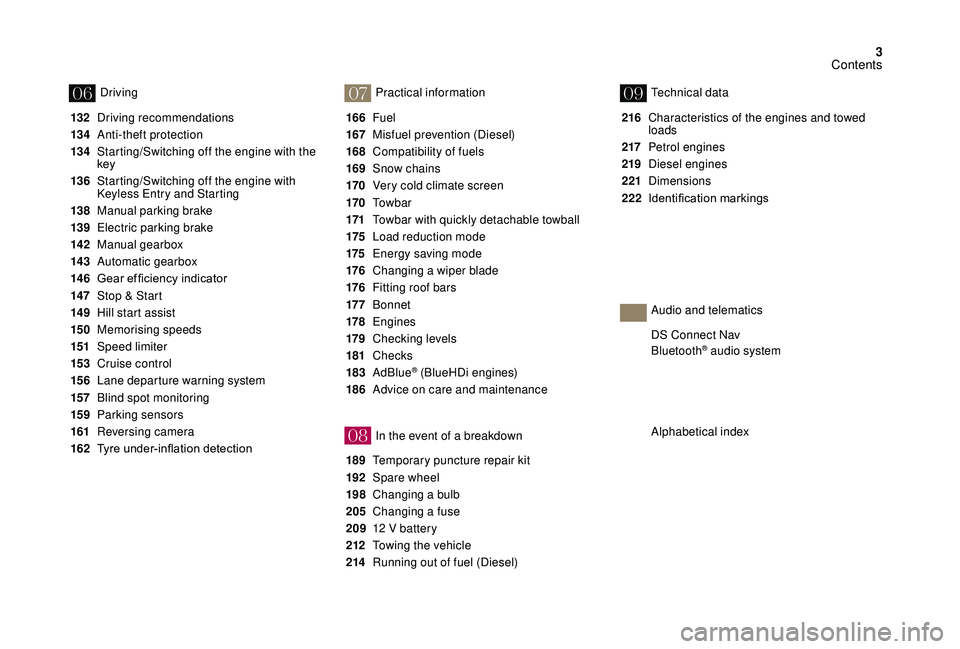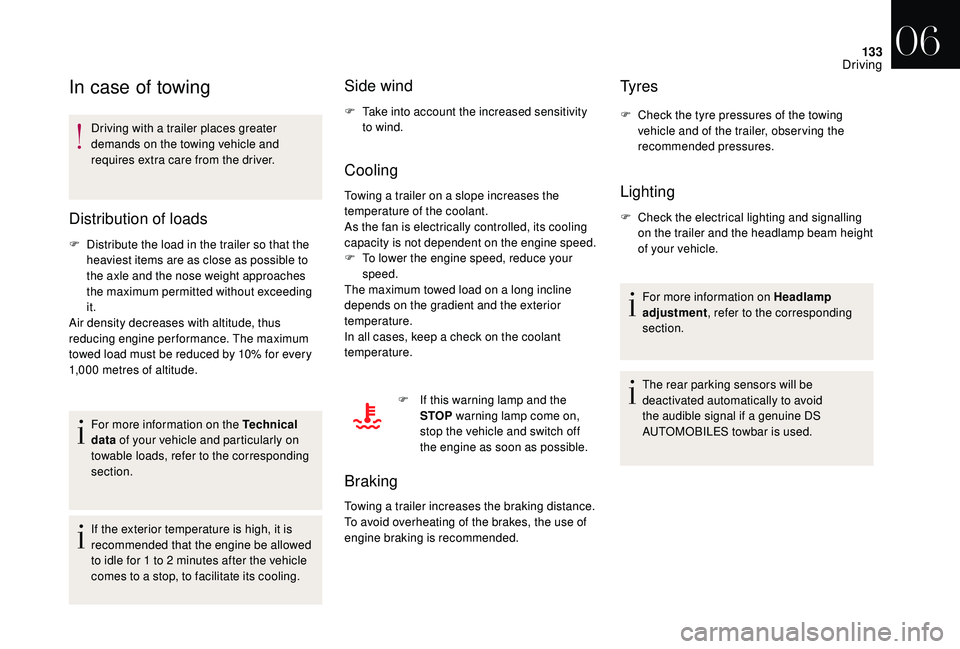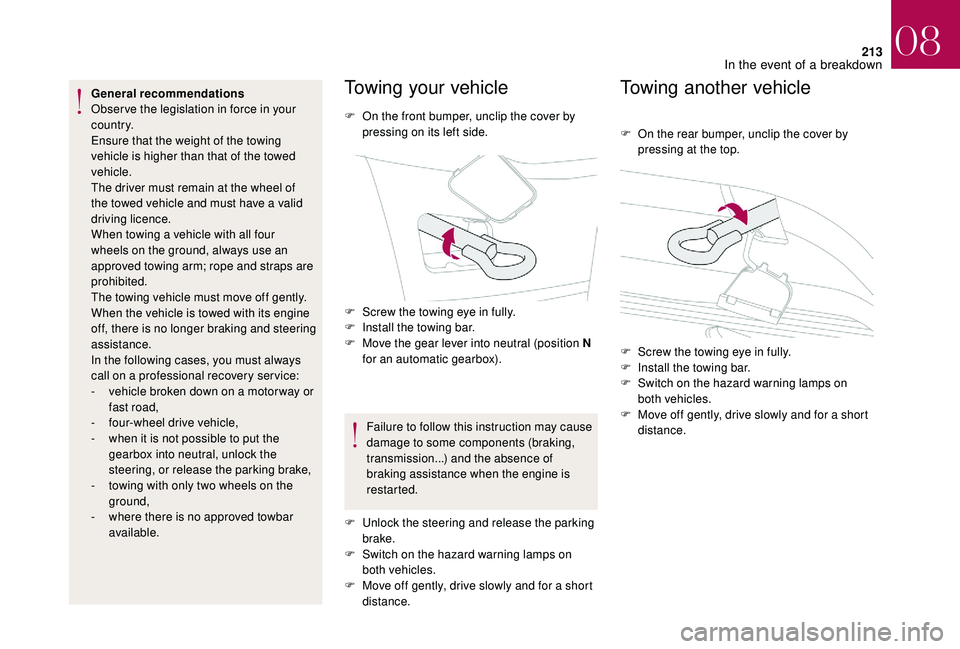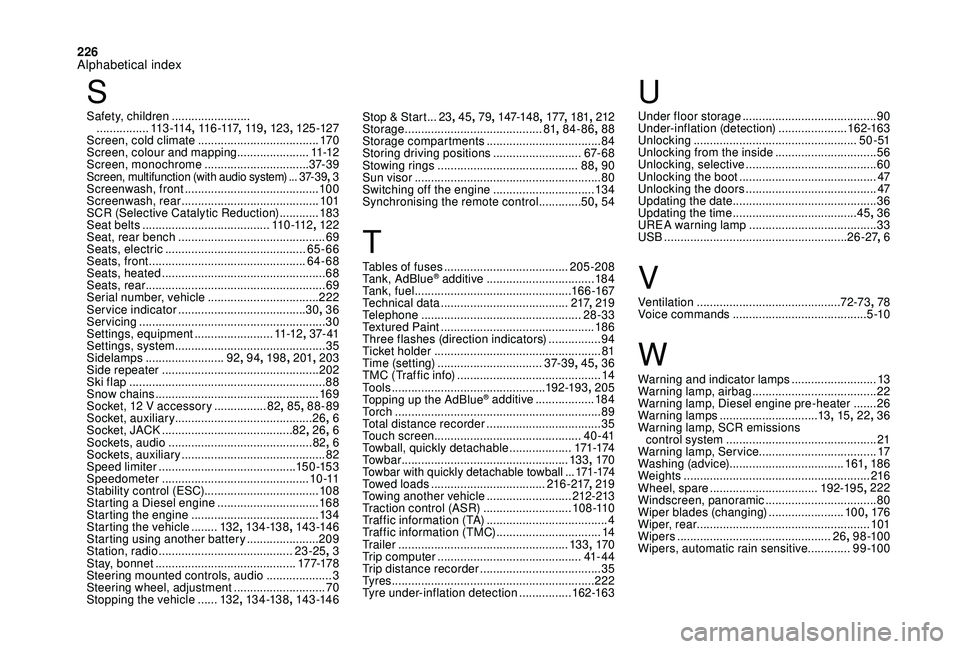tow bar CITROEN DS4 2023 Owners Manual
[x] Cancel search | Manufacturer: CITROEN, Model Year: 2023, Model line: DS4, Model: CITROEN DS4 2023Pages: 296, PDF Size: 9.91 MB
Page 5 of 296

3
07
08
0609
132 Driving recommendations
13 4
A
nti-theft protection
13 4
S
tarting/Switching off the engine with the
key
136
S
tarting/Switching off the engine with
Keyless Entry and Starting
138
M
anual parking brake
139
E
lectric parking brake
142
M
anual gearbox
14 3
Aut
omatic gearbox
14 6 Gear
ef ficiency indicator
14
7
St
op & Start
14 9
H
ill start assist
15 0
M
emorising speeds
151
Spe
ed limiter
15 3
C
ruise control
15 6
L
ane departure warning system
157
B
lind spot monitoring
15 9
P
arking sensors
161
R
eversing camera
162 Tyre
under-inflation detection 166
Fuel
167
M
isfuel prevention (Diesel)
168
C
ompatibility of fuels
169
S
now chains
170
V
ery cold climate screen
170
T
o w b a r
171
T
owbar with quickly detachable towball
175
L
oad reduction mode
175
E
nergy saving mode
176
C
hanging a wiper blade
176
F
itting roof bars
17 7
B
onnet
178
E
ngines
179
Ch
ecking levels
181
Checks
183
AdBlue
® (BlueHDi engines)
186
A
dvice on care and maintenance
189
T
emporary puncture repair kit
192
S
pare wheel
198
C
hanging a bulb
205
C
hanging a fuse
209
1
2 V battery
212
T
owing the vehicle
214
R
unning out of fuel (Diesel) 216
C
haracteristics of the engines and towed
loads
217
Pe
trol engines
219
D
iesel engines
221
Dimensions
222 Identification
ma
rkings
Driving
Practical information
In the event of a breakdownTechnical data
Alphabetical index DS Connect Nav
Bluetooth
® audio system
Audio and telematics
Contents
Page 135 of 296

133
In case of towing
Driving with a trailer places greater
demands on the towing vehicle and
requires extra care from the driver.
Distribution of loads
F Distribute the load in the trailer so that the heaviest items are as close as possible to
the axle and the nose weight approaches
the maximum permitted without exceeding
it.
Air density decreases with altitude, thus
reducing engine performance. The maximum
towed load must be reduced by 10% for every
1,000 metres of altitude.
For more information on the Technical
data of your vehicle and particularly on
towable loads, refer to the corresponding
section.
If the exterior temperature is high, it is
recommended that the engine be allowed
to idle for 1 to 2 minutes after the vehicle
comes to a stop, to facilitate its cooling.
Side wind
F Take into account the increased sensitivity to wind.
Cooling
Towing a trailer on a slope increases the
temperature of the coolant.
As the fan is electrically controlled, its cooling
capacity is not dependent on the engine speed.
F
T
o lower the engine speed, reduce your
speed.
The maximum towed load on a long incline
depends on the gradient and the exterior
temperature.
In all cases, keep a check on the coolant
temperature.
F
I
f this warning lamp and the
STOP warning lamp come on,
stop the vehicle and switch off
the engine as soon as possible.
Braking
Towing a trailer increases the braking distance.
To avoid overheating of the brakes, the use of
engine braking is recommended.
Ty r e s
F Check the tyre pressures of the towing vehicle and of the trailer, observing the
recommended pressures.
Lighting
F Check the electrical lighting and signalling on the trailer and the headlamp beam height
of your vehicle.
For more information on Headlamp
adjustment , refer to the corresponding
section.
The rear parking sensors will be
deactivated automatically to avoid
the audible signal if a genuine DS
AUTOMOBILES towbar is used.
06
Driving
Page 161 of 296

159
F To deactivate the system, press this button again; the warning lamp goes off.
The status of the system remains in memory
when the ignition is switched off.
The system is automatically deactivated
when towing with a towbar approved by
DS AUTOMOBILES.
Malfunction
In the event of a fault, the warning lamp in the
button flashes then goes off.
Contact the dealer network or a qualified
workshop. The system may suffer temporary
interference in certain weather conditions
(rain, hail, etc.).
In particular, driving on a wet sur face
or moving from a dry area to a wet area
can cause false alerts (for example, the
presence of a fog of water droplets in
the blind spot angle is interpreted as a
vehicle).
In bad or wintry weather, ensure that the
sensors are not covered with mud, ice or
snow.
Take care not to cover the warning zone in
the door mirrors or the detection zones on
the front and rear bumpers with adhesive
labels or other objects; they may hamper
the correct operation of the system.
Parking sensors
This system cannot in any circumstances
replace the need for vigilance on the part
of the driver.
This system indicates the proximity of an
obstacle (person, vehicle, tree, gate, etc.)
entering the detection range of the sensors
located in the bumper.
Certain types of obstacle (post, roadworks
cone, etc.) detected initially will no longer
be detected at the end of the manoeuvre, if
they are located in blind spots in the sensors'
detection range.
06
Driving
Page 162 of 296

160
Rear parking sensors
The system is switched on by engaging reverse
g e a r.
This is confirmed by an audible signal.
The system is switched off when you come out
of reverse gear.
Audible assistanceVisual assistanceThis supplements the audible signal by
displaying bars in the screen which move
progressively nearer to the vehicle.
When the obstacle is very close, the "Danger"
symbol is displayed in the screen.
Front parking sensors
In addition to the rear parking sensors, the
front parking sensors are triggered when an
obstacle is detected in front and the speed of
the vehicle is still below 6 mph (10 km/h).
The front parking sensors are interrupted if
the vehicle stops for more than three seconds
in for ward gear, if no further obstacles are
detected or when the speed of the vehicle
exceeds 6 mph (10 km/h).
The sound emitted by the speaker (front or
rear) indicates whether the obstacle is in
front or behind.
Deactivation/activation of the
front and rear parking sensors
The function is deactivated by pressing this
button. The button indicator lamp comes on.
Pressing this button again reactivates the
function. The button indicator lamp goes off.
The function will be deactivated
automatically if a trailer is being towed or a
bicycle carrier is fitted (vehicle fitted with a
towbar or an approved bicycle carrier).
The proximity information is given by an
intermittent audible signal, the frequency of
which increases as the vehicle approaches the
obstacle.
The sound emitted by the speaker (right or
left) indicates the side on which the obstacle is
located.
When the distance between the vehicle and
the obstacle becomes less than approximately
thirty centimetres, the audible signal becomes
continuous.
06
Driving
Page 172 of 296

170
Very cold climate screen
(Depending on the country of sale.)
Removable protective screen which prevents
the accumulation of snow at the radiator
cooling fan.
Fitting
F Position the very cold climate screen to the front of the lower section of the front
b u m p e r.
F
P
ress around its edge to engage its fixing
clips one by one.
Removing
F Use a screwdriver as a lever to release each fixing clip.
The very cold climate screen must be
removed when:
-
t
he exterior temperature exceeds
10°C,
-
w
hen towing,
-
a
t speeds above 75 mph (120 km/h).
To w b a r
Your vehicle is primarily designed for
transporting people and luggage, but it may
also be used for towing a trailer.We recommend the use of genuine
DS AUTOMOBILES towbars and their
harnesses that have been tested and
approved from the design stage of your
vehicle, and that the fitting of the towbar
is entrusted to a dealer or a qualified
workshop.
If the towbar is not fitted by a dealer, it
must still be fitted in accordance with the
vehicle manufacturer's instructions. Driving with a trailer places greater
demands on the towing vehicle and the
driver must take particular care.
For more information on Driving advice
,
particularly when towing, refer to the
corresponding section.
Obser ve the maximum authorised towable
weight, indicated on your vehicle's
registration certificate, the manufacturer's
label as well as in the Technical data
section of this guide.
Complying with the maximum
authorised nose weight (towball)
also includes the use of accessories
(bicycle carriers, tow boxes, etc.).
The maximum authorised nose weight
does not depend on the type of device
installed, fixed or removable, with or
without a tool.
07
Practical information
Page 173 of 296

171
Towbar with quickly
detachable towball
Presentation
This towbar allows the towball to be fitted and
removed quickly and easily without the use of
tools. Installed behind the bumper, the device
is invisible after the towball has been removed
and the trailer harness carrier has been folded
away.
1. Carrier.
2. Protective plug.
3. Safety eye.
4. Folding trailer harness socket.
5. Detachable towball.
6. Locking/unlocking wheel.
7. Key-operated safety lock.
8. Locking wheel protector.
9. Ball protector.
10. Stowing bag.
A. Locked position
The locking wheel is not in contact with the
towball (gap of about 5 mm).
The green mark is visible.
The lock for the locking wheel is facing
rearward.
B. Unlocked position
The locking wheel is in contact with the towball.
The green mark is hidden.
The lock for the locking wheel is facing for ward. Obser ve the legislation in force in the
country in which you are driving.
For information on the maximum trailer
weight and the recommended nose
weight, refer to the Technical data section.
For more information on Towing a trailer
,
refer to the corresponding section.
Before each use
Check that the towball is correctly fitted,
verifying that:
-
t
he towball is correctly engaged
(position A ),
-
t
he safety lock is closed and the key
removed; the locking wheel can no
longer be operated,
-
t
he towball must not be able to move in
its carrier; test by shaking it with your
hand.
07
Practical information
Page 193 of 296

191
After about 7 minutes, if a pressure of
2 bars is not reached, this indicates
that the tyre is not repairable; contact a
network dealer or a qualified workshop for
assistance.
F
P
lace the switch in the " O" position.
F
D
isconnect the compressor's electric plug
from the vehicle's 12 V socket.
F
R
eplace the cap on the valve.
F
R
emove the kit.
F
R
emove and then store the bottle of sealant. Take care, the sealant product is harmful
if swallowed and causes irritation to the
eyes.
Keep this product out of the reach of
children.
The use-by date for the liquid is marked
on the bottle.
After use, do not discard the bottle by the
roadside, take it to a member of the dealer
network or an authorised waste disposal
site.
Do not forget to obtain a new bottle of
sealant, available from the dealer network
or a qualified workshop.
Do not exceed the speed of 50 mph
(80
km/h) when driving with a tyre repaired
using this type of kit.
Checking/adjusting tyre
pressures
You can also use the compressor,
without injecting sealant, to check and if
necessary adjust the tyre pressures.
F
R
emove the valve cap from the tyre and
place it in a clean area.
F
U
ncoil the pipe stowed under the
compressor.
F
S
witch on the compressor by moving the
switch to the position " I" until the tyre
pressure reaches 2.0 bars. The sealant is
injected under pressure into the tyre; do not
disconnect the hose from the valve during
this operation (risk of splashing).
F
D
rive immediately for approximately three
miles (five kilometres), at reduced speed
(between 12 and 37 mph (20 and 60 km/h)),
to plug the puncture.
F
S
top to check the repair and measure the
tyre pressure using the kit.
F
S
crew the pipe onto the valve and tighten
f i r m l y.
08
In the event of a breakdown
Page 215 of 296

213
General recommendations
Obser ve the legislation in force in your
c o u nt r y.
Ensure that the weight of the towing
vehicle is higher than that of the towed
vehicle.
The driver must remain at the wheel of
the towed vehicle and must have a valid
driving licence.
When towing a vehicle with all four
wheels on the ground, always use an
approved towing arm; rope and straps are
prohibited.
The towing vehicle must move off gently.
When the vehicle is towed with its engine
off, there is no longer braking and steering
assistance.
In the following cases, you must always
call on a professional recovery ser vice:
-
v
ehicle broken down on a motor way or
fast road,
-
f
our-wheel drive vehicle,
-
w
hen it is not possible to put the
gearbox into neutral, unlock the
steering, or release the parking brake,
-
t
owing with only two wheels on the
ground,
-
w
here there is no approved towbar
available. Towing your vehicle
F On the front bumper, unclip the cover by pressing on its left side.
F
S
crew the towing eye in fully.
F
I
nstall the towing bar.
F
M
ove the gear lever into neutral (position N
for an automatic gearbox).
Failure to follow this instruction may cause
damage to some components (braking,
transmission...) and the absence of
braking assistance when the engine is
restarted.
F
U
nlock the steering and release the parking
brake.
F
S
witch on the hazard warning lamps on
both vehicles.
F
M
ove off gently, drive slowly and for a short
distance.
Towing another vehicle
F On the rear bumper, unclip the cover by pressing at the top.
F
S
crew the towing eye in fully.
F
I
nstall the towing bar.
F
S
witch on the hazard warning lamps on
both vehicles.
F
M
ove off gently, drive slowly and for a short
distance.
08
In the event of a breakdown
Page 292 of 296

226
Stop & Start ...23 , 45 , 79, 147-148 , 17 7, 181 , 212Storage .......................................... 81, 84-86 , 88
Storage compartments ...................................84
Storing driving positions
........................... 6
7- 6 8
Stowing rings
........................................... 88, 90
Sun visor
...............................
..........................80
Switching off the engine
...............................13 4
Synchronising the remote control
.............50, 54
T
Tables of fuses ...................................... 20 5-208
Tank, AdBlue® additive ................................. 18 4
Ta n k , f u e l
................................................ 166 -167
Technical data
....................................... 217, 219
Telephone
..............................
...................28-33
Textured Paint
............................................... 18 6
Three flashes (direction indicators)
................ 94
T
icket holder
................................................... 81
Time (setting)
................................ 37- 3 9, 45, 36
TMC (Traffic info)
............................................ 14
T
o o l s
............................................... 192-193, 205
Topping up the AdBlue
® additive .................. 18 4
To r c h
............................................................... 89
Total distance recorder
................................... 35
Touch screen ............................................. 4 0 - 41
Towball, quickly detachable
................... 171-174
To w b a r
...............................
.................... 13 3, 170
Towbar with quickly detachable towball ...17 1-174Towed loads ................................... 216 -217, 219
Towing another vehicle ..........................212-213
Traction control (ASR)
...........................108 -110
Traffic information (TA)
.....................................4
Traffic information (TMC)
................................14
Tr a i l e r
...............
..................................... 13 3, 170
Trip computer
............................................ 41- 4 4
Trip distance recorder
..................................... 35
T
y r e s
.............................................................. 222
Tyre under-inflation detection
................162-163
S
Safety, children ........................
................ 113 -114, 11 6 -117 , 11 9, 123 , 125 -127
Screen, cold climate
..................................... 17
0
Screen, colour and mapping ......................11 -12
Screen, monochrome
................................37- 3 9
Screen, multifunction (with audio system) ...37- 3 9 , 3Screenwash, front ......................................... 10 0
Screenwash, rear .......................................... 101
SCR (Selective Catalytic Reduction)
............183
Seat belts
....................................... 11 0 -112, 12 2
Seat, rear bench
............................................. 69
Seats, electric
........................................... 65-66
Seats, front
...............................
.................64-68
Seats, heated
.................................................. 68
Seats, rear
....................................................... 69
Serial number, vehicle
..................................222
Service indicator
....................................... 30, 36
Servicing
......................................................... 3
0
Settings, equipment
........................11 -12, 37- 41
Settings, system
.............................................. 35
Sidelamps
........................ 92,
94, 198 , 201, 203
Side repeater
................................................ 202
Ski flap
..............................
..............................88
Snow chains
.................................................. 169
Socket, 12 V accessory
................82, 85 , 88-89
Socket, auxiliary
.......................................... 26,
6
Socket, JACK
........................................ 82, 26 , 6
Sockets, audio
............................................ 8
2, 6
Sockets, auxiliary
...............................
.............82
Speed limiter
.......................................... 15
0 -15 3
Speedometer
............................................. 1 0 -11
Stability control (ESC)................................... 108
Starting a Diesel engine
............................... 16
8
Starting the engine
....................................... 13
4
Starting the vehicle
........ 13
2, 13 4 -13 8 , 143 -14 6
Starting using another battery
......................209
Station, radio
...............................
..........23-25, 3
Stay, bonnet
........................................... 17 7-178
Steering mounted controls, audio
.................... 3
S
teering wheel, adjustment
............................ 70
S
topping the vehicle
......132, 13 4 -13 8 , 143 -14 6
U
Under floor storage ......................................... 90
Under-inflation (detection) .....................162-163
Unlocking
.................................................. 5 0 - 51
Unlocking from the inside
...............................56
Unlocking, selective
........................................ 60
Unlocking the boot
...............................
...........47
Unlocking the doors
........................................ 47
U
pdating the date
............................................ 36
U
pdating the time
...............................
.......45, 36
UREA warning lamp
....................................... 33
USB
........................................................ 26-27, 6
V
Ventilation ............................................ 72-73, 78
Voice commands ......................................... 5 -10
W
Warning and indicator lamps ..........................13
W arning lamp, airbag ...................................... 22
W
arning lamp, Diesel engine pre-heater
.......26
Warning lamps
.............................. 13, 15 , 22 , 36
Warning lamp, SCR emissions control system
.............................................. 21
Warning lamp, Service ....................................17
Washing (advice) ................................... 161, 18 6
Weights
...............
.......................................... 216
Wheel, spare
...............................
..192-195 , 222
W
indscreen, panoramic
.................................. 80
Wiper blades (changing)
....................... 10 0, 176
Wiper, rear ..................................................... 101
Wipers
............................................... 26, 9 8 -10 0
Wipers, automatic rain sensitive
............. 9 9 -10 0
Alphabetical index